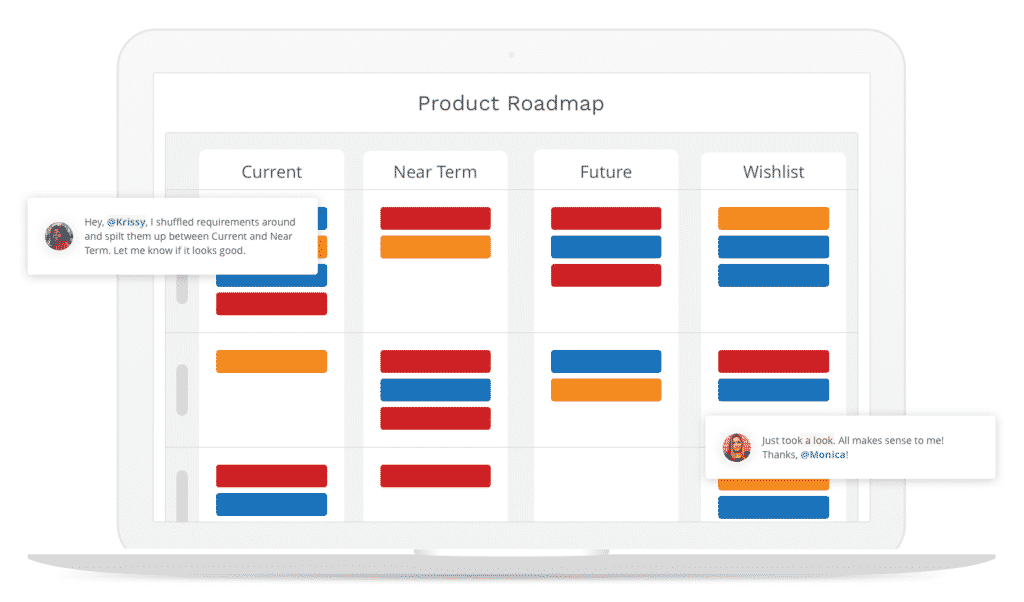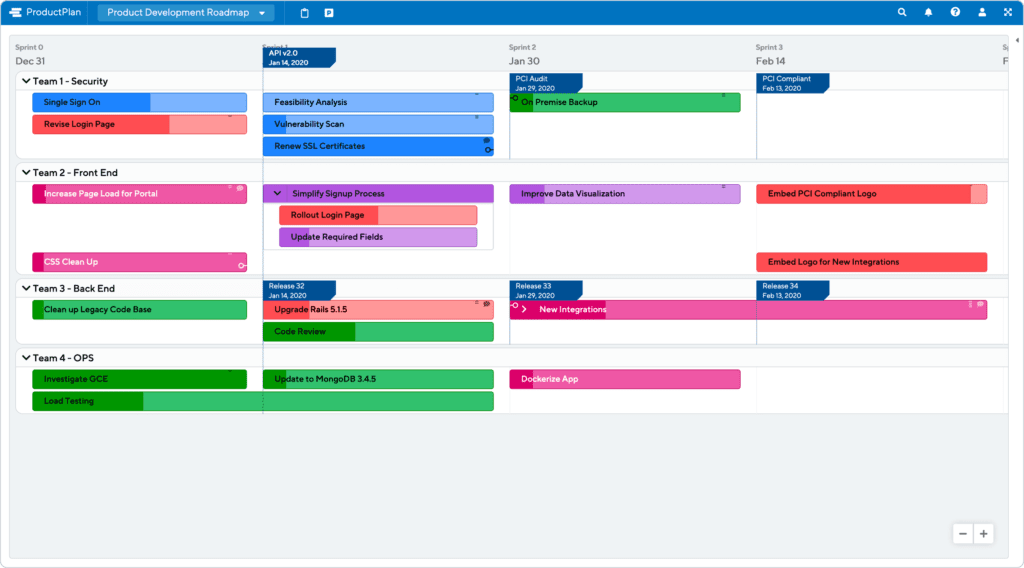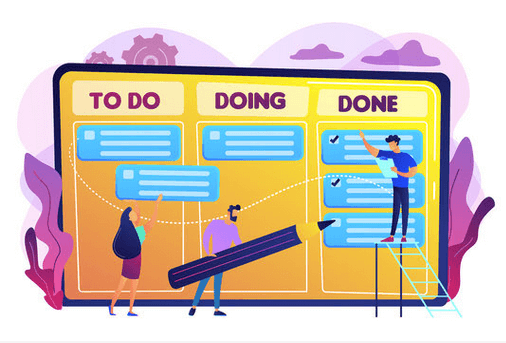What is Product Development?
Product development typically refers to all stages involved in bringing a product from concept or idea through market release and beyond. In other words, product development incorporates a product’s entire journey.
Standard Stages of Progress in Product Development
There are many steps to this process, and it’s not the same path for every organization, but these are the most common stages through which products typically progress:
-
Identifying a market need.
Products solve problems. So identifying a problem that needs solving (or a better way of being solved) is where this journey should begin. Conversations with potential customers, surveys, and other user research activities can inform this step.
-
Quantifying the opportunity.
Not every problem is problematic enough to warrant a product-based solution. However, the pain it causes and the number of people or organizations it impacts can determine whether it’s a worthy problem to solve and if people are willing to pay for a solution (be it with money or their data).
-
Conceptualizing the product.
Some solutions may be obvious, while others may be less intuitive. Here’s where the team puts in the effort and applies their creativity to devising how a product might serve its needs.
-
Validating the solution.
Before too much time is spent prototyping and design, whether the proposed solution is viable should be tested. Of course, this can still happen at the conceptual level. Still, it is an early test to see whether the particular product idea is worth pursuing further or if it will be rejected or only lightly adopted by the target user.
-
Building the product roadmap.
With a legitimate product concept in hand, product management can build out the product roadmap, identifying which themes and goals are central to develop first to solve the most significant pain points and spark adoption.
-
Developing a minimum viable product (MVP).
This initial version of the product needs just enough functionality to be used by customers.
-
Releasing the MVP to users.
Experiments can gauge interest, prioritize marketing channels and messages, and begin testing the waters around price sensitivity and packaging. It also kicks off the feedback loop to bring ideas, complaints, and suggestions into the prioritization process and populate the product backlog.
-
Ongoing iteration based on user feedback and strategic goals.
With a product in the market, enhancements, expansions, and changes will be driven by user feedback via various channels. Over time the product roadmap will evolve based on this learning and the objectives the company sets for this product. This work never ends until it’s finally time to sunset a product at the end of its lifecycle.

Product Development is Not Product Management
When you understand product development this way, you can see that it is not synonymous with product management, although many people mistakenly use the terms interchangeably. Indeed, product development does not refer to a single role at all.
In some organizations, “product development” may be shorthand for the implementation team, comprised primarily of developers, engineers, and possibly quality assurance.
But, when it comes to the house’s personnel side, it should instead view it as more of an overall process or method for bringing products to market, which involves many teams across a company, including:
- Product management
- Product marketing
- Project management
- Agile management (Scrum masters, product owners, etc.)
- Architecture
- Design
- UI/UX
- Development/Engineering
- Manufacturing
- Testing or QA
- Shipping/Distribution
Essentially, it encompasses everyone involved, from idea generation through to customer delivery. Each of these groups plays an essential role in the process, defining, designing, building, testing, or delivering the product.
How to Create a Product Development Plan in 3 Steps
Not to be confused with a project plan, a product development plan encompasses the overarching journey from idea to market. It should include and engage as many stakeholders as possible to ensure all of their specific needs, requirements, and concerns are being considered (if not addressed).
1. Start with a product vision.
It begins with a product vision, which aligns everyone around the shared objective for this product. This is followed by a product mission—the ultimate purpose of the product, who it is for, and what it does for them. Finally, it establishes some guiding principles for the work to come.
With product vision and mission statements in hand, primary goals for the product can be established. These may be a little fuzzier in the early stages, such as finding product-market fit, but they can rapidly evolve into measurable KPIs or OKRs. These measurable targets help shape which features, enhancements, and capabilities the product needs to achieve them.
2. Craft a roadmap.
Assuming customer research and validation has already occurred, the product team can then craft a product roadmap, prioritizing the significant themes to be addressed (we’ll dive further into product roadmaps next). Date-based milestones and targets can be established, but there should be a minimal focus on dates and maximum attention paid to creating value and adapting to the product goals and performance against key metrics.

3. Implement the roadmap for maximum impact.
Once the product roadmap is agreed upon, it’s time to make things happen. Implementation teams can create schedules, break down significant themes into sprints, and generate iterations of the product. This creates a feedback loop from customers, the sales team, and support, identifying new opportunities, pointing out shortcomings, and shining a light on areas to hone, improve, and expand.
From here, it’s a cycle of reviewing data, synthesizing feedback, and continually updating the product roadmap while grooming the product backlog to ensure every development cycle is utilized for maximum impact.
How Do Product Roadmaps Fit Into Product Development?
Whether you start at the conceptualization stage or first try to identify and validate a market need—you will want to have a system in place for prioritizing, summarizing, and capturing your product’s key objectives and significant themes.
The ideal tool for this early-stage planning is a product roadmap designed to strategically and visually convey your high-level product. So why is it essential to build your roadmap visually? There are several reasons to do so, but here are the two primary benefits:
1. With a visual product roadmap, you and your team can more easily refer back to the product strategy you agreed on and quickly reacquaint yourself with those high-level objectives to make sure you’re still on track.

Contrast this visual, easy-to-review roadmap with a typical spreadsheet-based roadmap loaded with features and to-do items arranged in no particular order, and you can understand why dedicated roadmapping software makes all the difference.
A visually appealing roadmap can also help a product manager present its strategic goals and plans more compellingly to the company’s executives and other key stakeholders.
Earning this buy-in is often necessary to secure organizational approval to move ahead with new product development. Therefore, it makes sense to give your product roadmap every advantage you can before presenting it to your stakeholders.
What is Agile Product Development?
Agile product development is another term you might hear often. This refers to the familiar product development concept we described in the introduction—all steps involved in delivering a product to the market—including agile software development principles, such as rapid iteration based on user feedback.
The benefit of the agile framework is that it allows an organization to shorten the cycle from brainstorming through actually launching a product—because the product team intentionally pushes out versions of the product (starting with its early-stage MVP) much more quickly and with much fewer updates and improvements in each release. In addition, this allows the team to enlist the feedback of actual users to make the product better incrementally.
A More Literal Definition of Product Development
Finally, you might also encounter a far more narrow definition of product development, describing the product’s actual development: This would be the coding stage in software or manufacturing in a physical product).
When it comes to software, development teams can create and maintain their product development roadmaps to prioritize, summarize, and communicate their plans to build and ultimately release the product. For example, below is a product development roadmap template that your team can use to stay on track during the development process.

Takeaways: Where the Magic Happens in Agile
Product development is the hard part. It’s where bright ideas collide with reality and where utopian visions of the future crash into the limitations of technology and headcount that separates dreamers from doers.
To avoid a promising product vision from faltering in the face of challenging work and difficult hurdles, roadmap strategies should be tightly coupled with Agile planning to optimize the work being done. To learn more about how rapid iteration can stay true to long-term objectives, check out this webinar.



